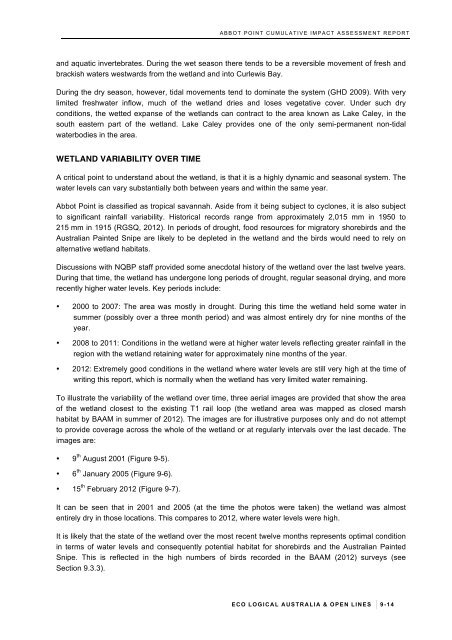Chapter 9 – Migratory shorebirds and the Australian Painted Snipe
Chapter 9 – Migratory shorebirds and the Australian Painted Snipe
Chapter 9 – Migratory shorebirds and the Australian Painted Snipe
You also want an ePaper? Increase the reach of your titles
YUMPU automatically turns print PDFs into web optimized ePapers that Google loves.
ABBOT POINT CUMULATIVE IMPACT ASSESSMENT REPORT<br />
<strong>and</strong> aquatic invertebrates. During <strong>the</strong> wet season <strong>the</strong>re tends to be a reversible movement of fresh <strong>and</strong><br />
brackish waters westwards from <strong>the</strong> wetl<strong>and</strong> <strong>and</strong> into Curlewis Bay.<br />
During <strong>the</strong> dry season, however, tidal movements tend to dominate <strong>the</strong> system (GHD 2009). With very<br />
limited freshwater inflow, much of <strong>the</strong> wetl<strong>and</strong> dries <strong>and</strong> loses vegetative cover. Under such dry<br />
conditions, <strong>the</strong> wetted expanse of <strong>the</strong> wetl<strong>and</strong>s can contract to <strong>the</strong> area known as Lake Caley, in <strong>the</strong><br />
south eastern part of <strong>the</strong> wetl<strong>and</strong>. Lake Caley provides one of <strong>the</strong> only semi-permanent non-tidal<br />
waterbodies in <strong>the</strong> area.<br />
WETLAND VARIABILITY OVER TIME<br />
A critical point to underst<strong>and</strong> about <strong>the</strong> wetl<strong>and</strong>, is that it is a highly dynamic <strong>and</strong> seasonal system. The<br />
water levels can vary substantially both between years <strong>and</strong> within <strong>the</strong> same year.<br />
Abbot Point is classified as tropical savannah. Aside from it being subject to cyclones, it is also subject<br />
to significant rainfall variability. Historical records range from approximately 2,015 mm in 1950 to<br />
215 mm in 1915 (RGSQ, 2012). In periods of drought, food resources for migratory <strong>shorebirds</strong> <strong>and</strong> <strong>the</strong><br />
<strong>Australian</strong> <strong>Painted</strong> <strong>Snipe</strong> are likely to be depleted in <strong>the</strong> wetl<strong>and</strong> <strong>and</strong> <strong>the</strong> birds would need to rely on<br />
alternative wetl<strong>and</strong> habitats.<br />
Discussions with NQBP staff provided some anecdotal history of <strong>the</strong> wetl<strong>and</strong> over <strong>the</strong> last twelve years.<br />
During that time, <strong>the</strong> wetl<strong>and</strong> has undergone long periods of drought, regular seasonal drying, <strong>and</strong> more<br />
recently higher water levels. Key periods include:<br />
• 2000 to 2007: The area was mostly in drought. During this time <strong>the</strong> wetl<strong>and</strong> held some water in<br />
summer (possibly over a three month period) <strong>and</strong> was almost entirely dry for nine months of <strong>the</strong><br />
year.<br />
• 2008 to 2011: Conditions in <strong>the</strong> wetl<strong>and</strong> were at higher water levels reflecting greater rainfall in <strong>the</strong><br />
region with <strong>the</strong> wetl<strong>and</strong> retaining water for approximately nine months of <strong>the</strong> year.<br />
• 2012: Extremely good conditions in <strong>the</strong> wetl<strong>and</strong> where water levels are still very high at <strong>the</strong> time of<br />
writing this report, which is normally when <strong>the</strong> wetl<strong>and</strong> has very limited water remaining.<br />
To illustrate <strong>the</strong> variability of <strong>the</strong> wetl<strong>and</strong> over time, three aerial images are provided that show <strong>the</strong> area<br />
of <strong>the</strong> wetl<strong>and</strong> closest to <strong>the</strong> existing T1 rail loop (<strong>the</strong> wetl<strong>and</strong> area was mapped as closed marsh<br />
habitat by BAAM in summer of 2012). The images are for illustrative purposes only <strong>and</strong> do not attempt<br />
to provide coverage across <strong>the</strong> whole of <strong>the</strong> wetl<strong>and</strong> or at regularly intervals over <strong>the</strong> last decade. The<br />
images are:<br />
• 9 th August 2001 (Figure 9-5).<br />
• 6 th January 2005 (Figure 9-6).<br />
• 15 th February 2012 (Figure 9-7).<br />
It can be seen that in 2001 <strong>and</strong> 2005 (at <strong>the</strong> time <strong>the</strong> photos were taken) <strong>the</strong> wetl<strong>and</strong> was almost<br />
entirely dry in those locations. This compares to 2012, where water levels were high.<br />
It is likely that <strong>the</strong> state of <strong>the</strong> wetl<strong>and</strong> over <strong>the</strong> most recent twelve months represents optimal condition<br />
in terms of water levels <strong>and</strong> consequently potential habitat for <strong>shorebirds</strong> <strong>and</strong> <strong>the</strong> <strong>Australian</strong> <strong>Painted</strong><br />
<strong>Snipe</strong>. This is reflected in <strong>the</strong> high numbers of birds recorded in <strong>the</strong> BAAM (2012) surveys (see<br />
Section 9.3.3).<br />
ECO LOGICAL AUSTRALIA & OPEN LINES 9 - 14



